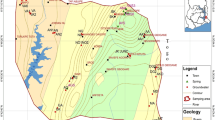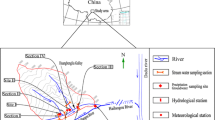Abstract
Many of the river basins in northwest China receive water from melting glaciers and snow in addition to groundwater. This region has experienced a significant change in glacier and snowpack volume over the past decade altering hydrology. Quantifying changes in water resources is vital for developing sustainable strategies in the region. During 2013, a water-isotope source apportionment study was conducted during the spring flood in the Yushugou River basin, northwestern China. The study found significant differences in water isotopes between river water, snowmelt water, and groundwater. During the study period, the isotopic composition of groundwater remained relatively stable. This stability suggests that the groundwater recharge rate has not been significantly impacted by recent hydro-climatic variability. The river water flow rate and water δ 18O displayed an inverse relationship. This relationship is indicative of snowmelt water injection. The relative contribution of the two sources was estimated using a two-component isotope hydrograph separation. The contribution of snowmelt water and groundwater to Yushugou River were ∼63% and ∼37%, respectively. From the study, we conclude that snowmelt water is the dominant water source to the basin during the spring melt period.




Similar content being viewed by others
References
Buttle J M 1994 Isotope hydrograph separations and rapid delivery of pre-event water from drainage basins; Progr. Phys. Geogr. 18 16–41.
Buttle J M 2005 Isotope hydrograph separation of runoff sources; In: Encyclopedia of hydrological sciences (ed.) Anderson M G, Wiley, London, pp. 1–12.
Blume T, Zehe E, and Bronstert A 2008 Investigation of runoff generation in a pristine, poorly gauged catchment in the Chilean Andes II: Qualitative and quantitative use of tracers at three spatial scales; Hydrol. Process. 22 3676–3688.
Craig H 1961 Standards for reporting concentrations of deuterium and oxygen-18 in natural waters; Science 133 1833–1834.
Chinese Academy of Sciences. Lanzhou institute of Glacial Permafrost 1986 China’s glaciers directory; Science Press, Beijing.
Clark I D and Fritz P 1997. Environmental Isotopes in Hydrogeology; CRC Press Lewis Publishers, Boca Raton, FL.
Dansgaard W 1964 Stable isotope in precipitation; Tellus 14 (4) 436–468.
Dincer T, Payne B R, Florkowski T, Martinec J, and Tongiorgi E 1970 Snowmelt runoff from measurements of Tritium and Oxygen-18; Water Resour. Res. 6 110–124.
Fasong Yuan and Miyamoto Seiichi 2008 Characteristics of oxygen-18 and deuterium composition in waters from the Pecos River in American southwest; J. Chem. Geol. 255 220–230.
Fritz P, Cherry J A, Weker K U and Sklash M G 1976 Storm runoff analysis using environmental isotopes and major ions; In: Interpretation of Environmental Isotopes and Hydrochemical Data in Groundwater Hydrology, IAEA: Vienna, pp. 111–131.
Fan Zili and Ma Yingjun 2000 Some issues about the exploitation and the relation utilization of water resources in the arid areas; Arid Zone Res. 17(3) 6–11.
Gonfiantini R 1986 Environmental isotopes in lake studies: Handbook of Environmental Isotope Geochemistry, The Terrestrial Environment (Amsterdam: Elsevier) 2 113–168.
Gu Weizu 1993 A case study on the hydrological significance of stable isotope data on alpine catchments with snow cover and glaciers, Xinjiang, China [C]//Snow and Glacier Hydrology (Proceedings of the Kathmandu Symposium), IAHS Publication.
Guo F., Shangguan Z., and Xia J. 1994 Determination of components of stormflow using stable isotopes and chemical compositions in Qianshui River of Anhui Province, China; Geochimica 23 (1) 42–49.
Genereux D P 1998 Quantifying uncertainty in tracer-based hydrograph separation; Water Resour. Res. 34 (4) 915–919.
Gremillion P and Wanielista M 2000 Effect of evaporative enrichment on the stable isotope hydrology of a central Florida (USA) river; Hydrol. Process. 14 1465–1484.
Harrington G A, Cook P G, and Herczeg A L 2002 Spatial and temporal variability of ground water recharge in central Australia: A tracer approach; Ground Water 40 (5) 518–528.
HeYuanqing T. W H., and Yao T., et al. 2001 The isotopic record at an alpine glacier and its implieations for local climatic changes and isotopic homogenization processes; J. Glaciol. 47 (156) 147–151.
Hinton M J, Schiff S L, and English M C 1994 Examining the contribution of glacial till water to storm runoff using two and three-component hydrograph separations; Water Resour. Manag. 30 983–993.
Hoeg S, Uhlenbrook S and Leibundgut C 2000 Hydrograph separation in a mountainous catchment-combining hydrochemical and isotopic tracers; Hydrol. Process. 14 1199–1216.
Hooper R P, Christophersen N, and Peters N E 1990 Modelling streamwater chemistry as a mixture of soilwater end-members – an application to the Panola Mountain catchment, Georgia, USA; J. Hydrol. 116 321–343.
Huth A K, Leydecker A and Sickman J O et al. 2004 A two-component hydrograph separation for three highelevation catchments in the Sierra Nevada, California; Hydrol. Process. 18 1721–1733.
Kline S J 1985 The purposes of uncertainty analysis; J. Fluids Eng. 107 153–160.
Kendall C 1993 Impact of isotope heterogeneity in shallow systems on shallow system on stormflow generation; Ph.D. Dissertation, University of Maryland, College Park, 310p.
Kendall C and Coplen T B 2001 Distribution of oxygen-18 and deuterium in river waters across the United States; J. Hydrol. Process. 15 1363–1393.
Kong Y L and Pang Z H 2012 Evaluating the sensitivity of glacier rivers to climate change based on hydrograph separation of discharge; J. Hydrol. 434–435 121– 129.
Lanzhou Institute of Glaciology and Geocryology Chinese Academy of Science 1986 Glacier Inventory of China(III)-Tianshan Mountains (Interior Drainage Area of Scattered Flow in East) [M]; Beijing, Science Press, pp. 69–70.
Laudon H and Slaymaker O 1997 Hydrograph separation using stable isotope, silica and electrical conductivity: An Alpine example; J. Hydrol. 2019(2) 82–101.
Laudon H, Hemond H F, Krouse R, et al. 2002 Oxygen 18 fractionation during snowmelt: Implications for spring flood hydrograph separation; Water Resour Res 38 40.1–40.10.
Liu F D, Xu Z, Wang Z S, and Liu S R 2008a Characteristics of water isotopes and hydrograph separation during the wet season in the Heishui River, China; J. Hydrol. 353 314–321.
Liu Y H, Fan N J, An S Q, Bai X H, Liu F D, Xu Z, Wang Z S, and Liu S R 2008b Characteristics of water isotopes and hydrograph separation during the wet season in the Heishui River, China; J. Hydrol. 353 314–321.
Luo G. et al. 1999. Analysis on the hydrologic properties of Yiwu River valley; Arid Land Geography (1).
Luo Guangxiao, Ai Li, and Qi Xianming et al. 2002 Hydrological characteristics of the Yushugou Valley; J. Xinjiang Meteorol. 25(5) 19–20, 37.
McDonnell J J, Luo Guangxiao, Ai Li, and Qi Xianming et al. 2002 Hydrological characteristics of the Yushugou Valley; Xinjiang Meteorol. 25(5) 19–20, 37.
Meyer S L 1975. Data Analysis for Scientists and Engineers, John Wiley, New York.
Moser H and Stichler W 1980 Environmental isotopes in snow and ice; Handbook of Environmental Isotope Geochemistry, 1. Rottedam: Elsevier Scientific Publishing Co., pp. 141–148.
Mast A M, Kendall C, and Campbell D H, et al. 1995 Determination of hydrological pathways in an alpine-subalpine basin using isotopic and chemical tracers, Loch Vale Watershed, Colorado, USA; IAHS Publ. 228 263– 270.
Mortathi J, Moraes J M, Rodrigues J C, Victoria R L, and Martinelli L A 1997 Hydrograph separation of the Amazon River using 18O as an isotopic tracer; Scientia Agricola 54 (3) 167–173.
Ma Xuejuan and Luo Guangxiao 2009 Impact analysis of climate change on runoff in Yushugou river basin; China Water Transport 9(10) 190–193.
Peters D G, Hayes J M and Hieftje G M 1974 Chemical Separations and Measurements: Theory and Practice of Analytical Chemistry, W B Saunders, Philadelphia, Pa, pp. 19–22.
Price R M, Swart P K and Willoughby H E 2008 Seasonal and spatial variation in the stable isotopic composition (δ 18O and δD) of precipitation in south Florida; J. Hydrol. 358 193–205.
Pu T., and He Y., et al. 2012 Characteristics of water stable isotopes and hydrograph separation in Baishui catchment during the wet season in Mt. Yulong region, southwestern China; Hydrol. Process. doi: 10.1002/hyp.9479.
Qu Simin, Bao Weimin and Shi Peng et al. 2006 Review on isotopic hydrograph separation; Water Resource and Power 24(1) 80–83.
Rodhe A 1984 Groundwater contribution to stream flow in Swedish forested till soil as estimated by oxygen-18; In: Isotope Hydrology 1983, IAEA, Vienna, pp. 55–56.
Raben P and Theakstone W H 1995 Changes of ionic and oxygen isotopic composition snowpack at the glacier Austre Okstind-breen, Norway; Nordic Hydrol. 29 1–20.
Sklash M G and Farvolden R N 1979 The role of groundwater in storm runoff; J. Hydrol. 43 46–65.
Song X, Kayane I and Tanaka T et al. 1999 A study of the groundwater cycle in Sri Lanka using stable isotopes; J. Hydrol. Process. 13 1479–1496.
Su Y H, Feng G F and Zhu G F 2009 Environmental isotopic and hydrochemical study of groundwater in the Ejina Basin, northwest China; J. Environ. Geol. 58 601–614.
Taylor J R 1982 An Introduction to Error Analysis: The Study of Uncertainties in Physical Measurements; Univ. Sci. Books, Mill Valley, California.
Tipler P A 1994 Physik. Lehrbuch, Spektrum der Wissenschaften; Spektrum Akademischer Verlag: Heidelberg, Germany.
Theakstone W H and Knudsen N T 1996 Oxygen isotope and ionic concentrations in glacial river water: multi-year observations in the Austre Okstindbreen basin, Norway; Nordic. Hydrol. 27 101–116.
Turner J, Bradd J, and Waite T 1992 Conjunctive use of isotopic techniques to elucidate solute concentration and flow processes in dryland salinized catchments; In: Isotope Techniques in Water Resources Development 1991, IAEA, Vienna, pp. 33–60.
Wang Hengchun 1990 Isotope hydrology geology; Beijing: Geology Publishing House, 1991: 49–50 (in Chinese).
Wang R. 2013. Based on Environmental Isotope Hydrograph Separation during Snowmelt Period-Taking Tianshan Mountains Juntang River basin as an Example, Master’s Thesis, Xingjiang University.
Watson R, Zinyowera M and Moss R et al. 1995 Impacts, adaptations and mitigation of climate change: Scientific technical analyses; In: Climate Change 1995 (Cambridge: Cambridge University Press), pp. 248–249.
Yanlong Kong and Zhonghe Pang 2012 Evaluating the sensitivity of glacier rivers to climate change based on hydrograph separation of discharge; J. Hydrol. 434–435 121–129.
Zhang Yinghua, Wu Yanqing and Wen Xiaohu et al. 2006 Application of environmental isotopes in water cycle; Adv. Water Sci. 17(5) 738–747.
Zhang Y H, Song X F, and Wu Y Q 2008 Use of oxygen-18 isotope to quantify flows in the upriver and middle reaches of the Heihe River, Northwestern China; Environ. Geol. 58 645–653.
Zhang H. and Liu H. 2011 Analysis of hydrology and water resources in Yushugou River basin in Xinjiang; Heilongjiang Science and Technology of Water Conservancy 39 (5) 8–9.
Acknowledgements
The authors thank Shufei Luo for helping in samples collection. They also thank engineer Zhu Yuman of Tianshan Glaciological Station for helping in chemical analysis. This research was supported by the Key Research Program of the Chinese Academy of Sciences (KJZD-EW-G03-01), National Major Science Research Project (973 projects) (2013CBA01801), the National Science Foundation of China (Nos. 41471058, 41171057, 41201065), and foundation for Excellent Youth Scholars of CAREERI, CAS (51Y251B51).
Author information
Authors and Affiliations
Corresponding author
Rights and permissions
About this article
Cite this article
Wang, X., Li, Z., Ross, E. et al. Characteristics of water isotopes and hydrograph separation during the spring flood period in Yushugou River basin, Eastern Tianshans, China. J Earth Syst Sci 124, 115–124 (2015). https://doi.org/10.1007/s12040-014-0517-x
Received:
Revised:
Accepted:
Published:
Issue Date:
DOI: https://doi.org/10.1007/s12040-014-0517-x




